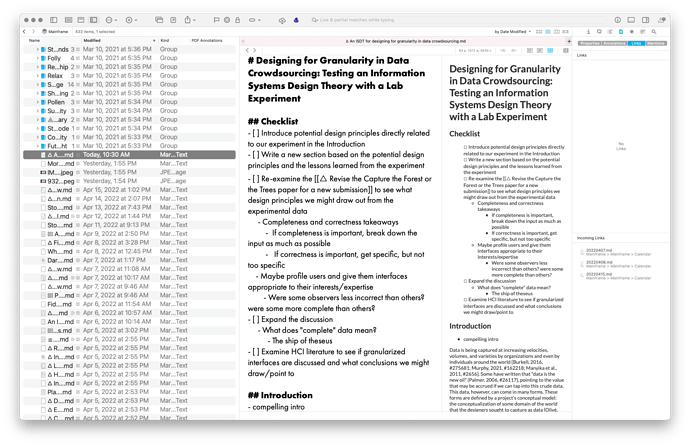OK, I have a bit of an update for everybody. I tried a bunch of the recommended apps, and here are some brief notes:
- Nota. Nota is nice, but doesn’t have an iOS app and also doesn’t allow the granularity for sorting that I’d like. You can pick how to sort each folder, but you can’t manually sort (which nobody lets you do, actually), and you can’t sort descending. So in my Daily Notes folder, the most recent date is waaaaaaaay down at the bottom if I sort by name, which is the sensible way to sort that folder.
- fsNotes. Super nice! But it doesn’t work well with checklists and todos. Seems kind of buggy.
- Notebooks. Doesn’t do Zettelkasten well (it doesn’t autofill anything and you need to be very specific about where your file is in the workspace). Doesn’t like checklists. It won’t render bullet lists and checklist items when you mix them up.
- Zettlr. Close, but it’s electron and doesn’t have an iOS app. It also doesn’t expand your Markdown links, and the typography is really weird. I’d prefer flat headings style with pound signs.
- Taio. Didn’t like how this one renders type, and it’s too clearly an iPad app on the Mac. It’s not what I’d want to spend my time in. It also struggles to render unordered lists.
Out of everything I’ve tried, Nota is by far the closest to what I’d want. You can make it include all your Markdown syntax, which is nice. But it also makes all of your assets live in one folder, which is madness to me. If I need an image in a note, the image (or other asset) should be stored in a relative subdirectory named after the file name of the note I’m editing. That way I can easily find it later. It also doesn’t include tags, for some reason, which feels like an obvious miss.
Nota is also very tab happy, and the tabs aren’t native macOS tabs, which is a little weird.
Other than that, it’s quite close. Too bad there isn’t also an iOS app.
I wanted to like fsNotes, but it just doesn’t jive with me at all. It’s good work though. Just not for me.
So I guess I’m going to have to make what I want. The closest thing around is Noteplan, which I could use, but I don’t like that it doesn’t expose file names to me as a user. And as I said originally, it doesn’t really do long-form writing that well and I don’t need the “plan” part. (I say that now, but just wait until I change my mind and immediately abandon this whole project.)
Anyway, for reference, I’ve got a few notes that I would consider “Zettelkasten killers” — as in, if this doesn’t all look good and get supported out of the box and render properly, then I don’t want to use the app. If you’d like to try these files out, I’ve put them on Dropbox for folks to sample.
Here’s why I included these notes:
- None of these notes are “small notes” you’d typically see people advocating Zettelkasten for, but they are perfect for something like Markdown or plaintext. Markdown-focused text editors like iA Writer usually render them well (so long as they support the task syntax).
- You’ll note that the Elden Ring bullet journal does not render well in Obsidian. Many other apps struggle with text and checklist items side by side. Some apps, like Taio, don’t use hanging indentations. Nota handles all this just fine. Noteplan handles it exceptionally, but Noteplan is also designed for exactly this use case.
- No app does the footnotes in Exodus 3 very well. In an ideal world, I’d be able to create footnotes and quickly add text to them. Ulysses does this well, but it also does it with quirky formatting that doesn’t follow strict Markdown syntax. Noteplan doesn’t render footnotes at all. There has to be some in between.
- The Setting Up AWS S3 Buckets note is a great way to reveal whether or not your Zettelkasten app handles images well. Nota succeeds here. Noteplan does quite well. This is also a great way to see how your Markdown editor of choice handles code blocks.
Until I build my own app, I’ll use Nota on the desktop, unless I need to see my tags, in which case I’ll use Obsidian. I’ll use Obsidian on mobile because of a dearth of options for this sort of work.

